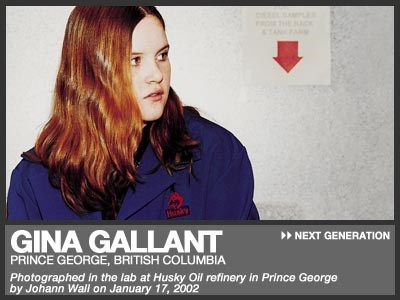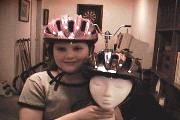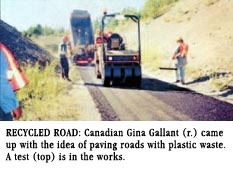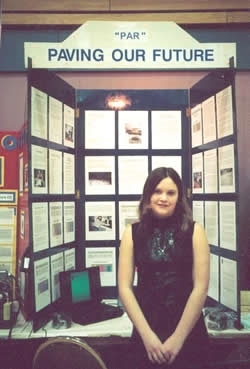 |
| Gina Gallant (google.com) |
Gina Gallant was born to be an inventor and a scientist. This grade 12 student from Prince George, British Columbia, Canada credits her life long interest in science to her father, Ken. "My dad started taking me to science fairs when I was 4. I used to wander around and loved seeing the backboards and talking to the scientists. I believe going to these fairs and seeing what people could accomplish was what mostly got me interested in science."
So by the time her grade one science project rolled around she was ready. Gina made paper out of the dreaded broccoli. She remembers, " My teachers were always there for me when I needed help. They also encouraged me, especially in times of obstacles." Her first invention came in grade 5 when she started working on a formula that would maintain a solid in a liquid base for 10 - 15 minutes. The reason? Gina wanted her crackers to stay crunchy and not go soggy in her soup. She says, "They have a special substance called substance "G" that I add to them to make them none soggy." It is a coating low in fat and cholesterol that she is keeping a secret, but if you are lucky enough to have soup at her house, you can be sure your crackers will stay crunchy.
 |
| Gina's Bicycle Helmet (helmets.org) |
Gina bases all her inventions on improving or sustaining life. "Take something you don't like and fix it", says the fiery redhead. "My second invention was a bicycle helmet that lights up in front and back when a child wears it correctly." It came about literally by accident. In 1998, Gina's little brother was hit by a car and survived because his bicycle helmet was properly secured. With her motivation in high gear, Gina spent 300 hours figuring out how to make a standard helmet safe for all kids. According to the Bicycle Helmet Institute, she succeeded. She attached LEDs (light emitting diodes, like the red lights that flash on the backs of some sneakers) to a standard helmet. The lights only light when the helmet is on the child's head in the safest position leading to a somewhat space-age style, which kids love. This patented invention won Gina a spot as a semi-finalist at the YTV Achievement Awards, a silver medal at the Canada-Wide Science Fair and gold medals in several regional science fairs.
 |
| Paving the road with PAR (google.com) |
<p?Gina considers herself an environmentalist and believes that science could provide the answers to many environmental problems. "In my latest invention PAR (PolyAggreRoad - see extra info) I wanted to utilize some of the waste going into our landfills. I came up with PAR while driving through Cache Creek, a small town near Vancouver that has the nickname, Trash Creek. Their landfill sites are full because all the surrounding areas are sending their trash to Cache Creek. Previous to this I was working on another project involving asphalt but because it was confidential I was not allowed to continue with the research. So I researched the idea regarding pavement and discovered that glass and rubber had already been used in the U.S. but neither worked. My theory was that they were not compatible with asphalt. Plastic and asphalt are both hydrocarbon based therefore they would have a natural bonding that would occur. This is why I chose plastic."
So back in late 2001, with the help of the media publicizing her desire to reuse plastic in a better environmental way, approximately 700 neighbors dropped off plastics at her house. She partnered with Husky Oil, (where her father works) to learn how to mix the plastic with sand, granite and liquid asphalt and Columbia Bitulithic, the local paving company, to make the mixture. It took a year, a 10 man crew and multiple tests and gradation changes to reach the finished project - a 500-metre stretch of PAR laid on Cranbrook Hill Road in Prince George, British Columbia, Canada. Says Gallant, "So far it's holding up perfectly and I've noticed the cracks disappearing from the melting plastic, which causes better expansion and contraction." She hopes, " this is one of many projects to help clean the planet."
 |
My Hero recently caught up with Gina in between preparing for her grade 12 grad, work and school. Here are some of her thoughts.
MH: Could you give us a simple scientific experiment that kids could do that might spark their interest in science? Maybe a website that helps kids get more into science?
GINA: "I don't think it's so much me giving you a website or idea that will spark a child's interest rather than them doing something in regards to their personal interests. When I do mentoring programs or speeches to children before science fairs I speak with them about needing to do something that they will like instead of making it a job. Have fun with it. That is the true meaning of science is "having fun and trying your best."
MH: Who's your favorite fictional character?
GINA: "I do a lot of reading in my spare time so my favorite fictional character would have to be Gaia Moore. She is the main character in a series called "Fearless." She has the abilities that most humans do not and she cannot feel fear. When she was born she was lacking the fear gene so nothing scares her. I would love to be fearless and not be scared to do the things I want to in life."
MH: What were your favorite toys, say between the age of 5 and 12?
GINA: "My all time favorite toy was (and still is) my teddy bear. His name is Rusty and he is white with a yellow night cap and he squeaks when you squeeze him. I also had a duck that when you pulled his rope he talked. I also enjoyed playing with cars and vehicles."
 |
| Gina and Friends (Gina Gallant) |
MH: What do you do for fun?
GINA: "I enjoy being a girl. I hang out with my friends "we go bowling, shopping and to play pool. Sometimes we just drive around in the car, listening to music. We have sleepovers and talk all night. I love reading, boxing, surfing and HOCKEY!"
MH: Who is your hero and why?
GINA: "I would have to say Albert Einstein is my hero. He went through so many things before he accomplished his dream. People ridiculed him and thought he was crazy, so for this he was sometimes an outcast but he still managed to complete his goals in life."
MH: What do you want to be when you get out of school? And which lucky University will be getting you?
GINA: "No University will be getting me, ha ha, don't think that. Yes I am going to school after grad, but I am attending Northern Alberta's Institute of Technology (NAIT). I would like to go into Chemical Technology."
MH: If you had the attention of the world for 5 minutes what would you say or do?
GINA: "There are so many things that I would love to say to the world but my first choice wouldn't be about the environment. I would ask them to look around them. Look at your family, friends, enemies and neighbors and tell me what you see. Look at the kids sitting in the corner of the cafeteria alone because no one will take a second to talk to them. Look at those kids and adults who are bullied by others and wonder what is it like being them? And then I would ask them to take a look at themselves. Are you really the person you want to be? The world isn't based on ideas or accomplishments--it starts with the people and if everyone fights and argues and bullies each other what is the future really going to be like? So I would ask them once again to take a look around and tell me what you see."
What I see is a great human being, Gina Gallant, who is marching into her scientific future with love in her heart, genius in her brain and a willingness to make the planet a better place.
Page created on 10/30/2007 4:03:53 PM
Last edited 1/9/2017 10:00:03 PM
GINA GALLANT IS A 2004 BARRON PRIZE for YOUNG HEROES winner.
Her letter to them explains PAR (PolyAggreRoad)
I base all of my inventions on improving or sustaining life. In my latest invention PAR (PolyAggreRoad) I wanted to utilize some of the waste going into our landfills. From the beginning of time our species has always developed new and improved solutions to problems mankind is faced with. One such problem that we faced in the 20th. century is how to mass mobilize people for everyday transportation. Engineers throughout the world designed today's modern roadway infrastructure. Building, maintaining and adding to present structures to keep up with an every-increasing pace of usage is not an easy task. As predictable as time itself, the solutions to our problems create other problems, increased traffic increases air and noise pollution.
PAR is designed to deal with some of these problems by using a specially engineered formula that uses landfill waste plastics. It reduces waste and absorbs noise generated by vehicles driving on it. PAR has been proven to be more stable and have less cracking and rutting than conventional asphalt used today. A relatively new area of study on roads and highways today is for a quieter paving material to reduce the volume of noise generated from traffic using it. Based on scientific data collected the PAR road, on average, had a lower noise level reading of 4.4 dba. This shows that PAR generated less noise levels than a road paved with conventional materials. The PAR road showed lower noise levels because less of the noise was reflected up and off the pavement, supporting my theory that some of the noise levels will be absorbed throughout the interwoven plastic and is either trapped or dispersed to the ground beneath the road. I had hoped to reduce landfill waste as well as reduce noise pollution. On both of these levels, based on the scientific data to date, I have accomplished both of these goals. Using PAR not only reduces roadway maintenance costs but it also shows a noise reduction of approximately 4-6%, lowering the amount of decibels to surrounding residences.
More and more from my younger years until now, I have become aware of the damage being done to our earth. I hope I may be able to inspire others to realize that their ideas, hopes and dreams can come true with work as well. Throughout my experiences I have been told many unforgettable things. A wise woman once said that: "No dream is too small to become reality, no effort goes unnoticed."
